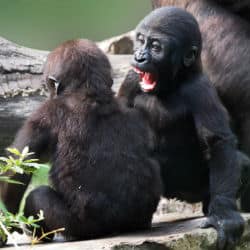Gorillas In The Mist

Diane Fossey the subject of the film “Gorillas in the Mist” who passed away in 1985 would probably be surprised there are any mountain gorillas left in the wild. Before she died, she grew increasingly alarmed by rising rates of poaching and deforestation in their habitat in Central Africa. Ms Fossey predicted before her death that by the turn of the millennium the species would disappear. Instead there has been intense conservation which has provided the species of great ape with whom humans share 98 per cent of DNA a second chance.
Increase in numbers
Generally speaking, the news has been good with the IUCN changing the status of mountain gorillas from “critically endangered’ to “endangered. This would not have been possible without what biologists refer to as “extreme conservation”. What that means in reality is monitoring every single gorilla in the rainforest and sometimes caring for them medically by cleaning wounds. It also means paying to protect the forest by sending cash to communities that may well have otherwise tried to convert the rainforest into farmlands.
Population still vulnerable
A decade ago, the number of mountain gorillas in the wild was just 680. Today the number now stands at over 1,000. The population is split across two populations spanning three countries, Congo, Uganda and Rwanda. Experts say the species is still vulnerable but are amazed by the remarkable growth in their numbers. Today it is possible to see the species up close and personal in their habitat by participating in tightly regulated groups hikes in the rainforests of Rwanda.
Tight restrictions on tourism
Groups are limited to eight people at a time and they are limited to one hour spent watching the gorillas. Groups are not permitted to carry food or even water bottles whilst near the animals so that the great ape is not exposed to germs should a silverback it decides it wants the items for themselves. Group guides instruct tourists not to make eye contact with gorillas for too long.
Careful to avoid over-exploitation
Tourists are also warned about rare acts of gorilla aggression. The tourists are instructed to look down and bend their knees which experts say is adopting a submissive pose. The number of tourists that can visit every day is strictly limited and the cost of the tour is not cheap at US$1,500 per visit. Conservationists want to balance the tension between the need to raise money and over-exploitation.
Maintaining a balance
Rwanda has been careful in maintaining that balance thanks to a plan its government adopted in 2005 where it would take five per cent of tourism income from Volcanoes National Park. The money earned is used to provide assistance to the villages surrounding the gorilla habitat. Two years ago, the government increased its take to ten per cent. US$2 million has been raised to pay for village projects so far. The government meets with communities every year and make sure it gives back.



